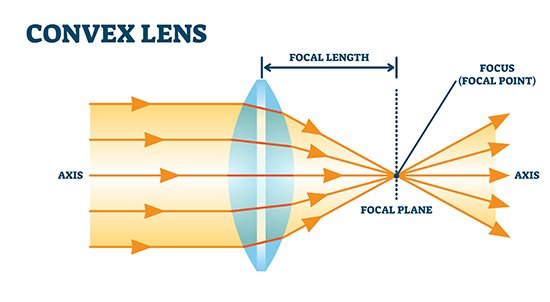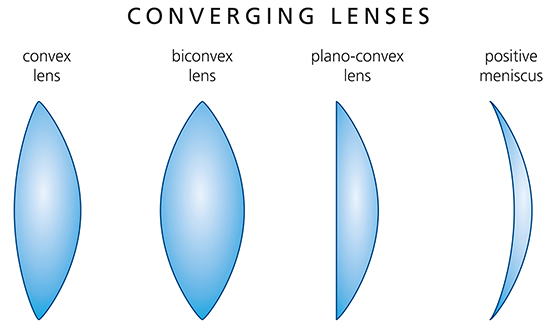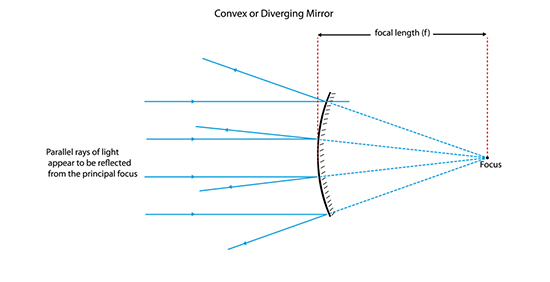p: (262) 548-1155
e: sales@advancedoptics.com
REQUEST A QUOTE
Woman Owned Small Business
OPTICAL LENSES AND CONVEX/CONCAVE MIRROR THEORY
Optical lenses are polished glass or plastic substrates that are shaped with one or more curved surfaces that transmit light. Optical lenses may be used either uncoated or with an antireflective coating depending on their intended application.
All optical lenses have a focal length which is the distance from the lens to the focal point along the optical axis of the lens. Three factors determine the focal length of a lens; the radius of curvature of the lens, the refractive index of the substrate from which the lens is made, and the medium in which the lens resides. Lenses that are highly curved and made from material with a high refractive index, and placed in a medium with a large difference in the refractive index will have a shorter focal length and will therefore be more powerful. The focal length of a lens can be calculated using the lens maker’s formula.
Convex Lenses
Convex lenses bulge outward from the center and converge light rays parallel to the optical axis to a focal point beyond the lens. Therefore, they may also be referred to as positive or converging lenses. The focal point is the point where the collimated light rays converge and come into focus.

Convex lenses can be manufactured in different configurations such as; biconvex, plano-convex, or as a positive meniscus.

Concave Lenses
Concave lenses curve inward from the center and diverge light rays parallel to the optical axis from a focal point behind the lens. Therefore, they may also be referred to as negative or diverging lenses. The focal point is the point where the collimated light rays appear to diverge from after passing through the lens.

Concave lenses can be manufactured in different configurations such as; biconcave, plano-concave, or as a negative meniscus.

Convex/Concave Mirrors
Optical lenses can be made into convex and concave mirrors by the addition of a reflective coating. However, as the mirror is reflecting light, as opposed to transmitting light, the focal point is reversed. As with lenses, the more curved the mirror is, the shorter its focal length will be, and hence the more powerful the mirror will be.
Convex Mirrors
Convex mirrors (Diverging Mirrors) have a surface that is curved outward so that collimated light diverges away from the reflective surface. The focal point is located behind the mirror and is referred to as a negative focal point. It is the point from which the light appears to have originated after reflection from the mirror.

Concave Mirrors
Concave mirrors (Focusing Mirrors) have a surface that is curved inward and therefore collects collimated light. The focal point is located in front of the mirror and is referred to as a positive focal point. It is the point at which the parallel beams of light focus after reflection from the mirror.

Advanced Optics custom manufactures glass convex and concave lenses and mirrors from 6mm to 530mm that can be purchased either uncoated or with a variety of coatings for use in the UV-VIS-NIR spectrum. To learn more about our capabilities and how to correctly specify the proper optic for your system, please visit our page Optical Lenses and Convex/Concave Mirrors for further information.
Have a question? Give us call and tell us about your project. (262) 548-1155
- Optical Mirrors
- AlSiO Economy Optical Mirror
- Bare Al Optical Mirror
- Borosilicate Optical Mirror
- Custom Optical Mirror
- First Surface Optical Mirrors
- Fused Silica Optical Mirror
- Precision Optical Mirror
- ZERODUR® Optical Mirror
- Round Optical Mirrors
- Rectangle Optical Mirrors
- Square Optical Mirrors
- λ/4 Optical Mirrors
- Standard 1" x 1", λ/4 Optical Mirror
- λ/10 Optical Mirrors
- λ/20 Optical Mirrors
- Selecting An Optical Mirror
- Optical Mirror 10 Step Design Chart
- Technical Data: Protected Mirrors
- Technical Data: Unprotected Mirrors
- Optical Mirror Cleaning
- Optical Windows
- Custom Optical Window
- Commercial Grade Optical Window
- Precision Optical Window
- Fused Silica Optical Windows
- N-BK7 Optical Windows
- Viosil Optical Windows
- Borosilicate Optical Windows
- Soda-lime Glass Optical Windows
- UV and IR Optical Windows
- λ/20 Optical Window
- Optical Window 10 Step Design Chart
- Optical Window Technical Information
- Optical Filters
- Dichroic Optical Filters
- Neutral Density Filters
- Colored Glass Absorptive Filters
- Optical Filters Technical Information
- Optical Lenses
- Optical Lenses Convex/Concave Mirror Theory
- Technical Data for Optical Materials
- Corning Fused Silica Data Sheet PDF
- BORO FLOAT Technical Data Sheet PDF
- N-BK7 Technical Data Sheet PDF
- Soda Lime Glass Technical Data Sheet PDF
- Fused Quartz Data Sheet PDF
- Zerodur Technical Data Sheet PDF
- Clearceram(C) Data Sheet PDF
- ULE® Low Expansion Glass Data Sheet PDF
- Viosil Data Sheet PDF
-
P.O. Box 117, Pewaukee, WI 53072-0117, USA
-
(262) 548-1155
Fax (262) 548-1153
